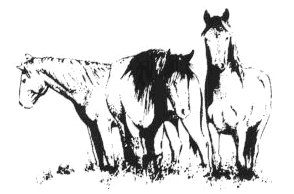|
The following report appeared in the Salt Lake Tribune:RENO, Nev. -- If a new advisory board recommends it, Bureau of Land Management Director Pat Shea says he would agree to euthanize "unadoptable" wild horses that are removed from overgrazed Western rangeland.Shea acknowledged Monday that BLM employees killing unwanted wild horses would be a public relations "nightmare," but said the romanticized notion of free-roaming mustangs must be checked by the reality of too many horses destroying public lands. "Are we going to run these animals as a livestock operation and manage it like a rancher would, or are we going to have wilderness and let the natural predators take care of the problem?" Shea said at the opening of a national Wild Horse and Burro Advisory Board meeting. "We've done a little here and a little there, and that makes for a foul soup." Whether to kill unwanted, excess mustangs was only one unsavory ingredient in the mix Monday, as Shea and members of the newly established board heard from three independent fact-finders -- a certified public accountant who looked at the BLM's inventory process, a veterinarian who assessed herd health and the editor of The Salt Lake Tribune, who analyzed BLM's response to critical national press accounts of wild-horse management. The three delivered a long list of problems with the federal wild-horse program, which costs taxpayers about $17 million annually, including:
High-Tech Solutions: Ideas being considered to remedy the problems include using computer-chip ear tags to track wild horses and conducting wild-horse adoptions over the Internet to meet demand. But the dilemma of too many wild horses -- many of which are more than 10 years old and not desirable by adopters -- dominated much of the debate of the board, which is charged with helping Shea fix the ailing program. "These horses are legends and we need to keep them alive," said board member Naomi Tyler of Boise, who 16 years ago adopted an "un-adoptable" wild horse that became a national champion endurance racehorse. "We should not treat them as rodents and just get rid of the excess rodents. People want these horses." BLM Wild Horse Program Leader Tom Pogacnik said the public wants younger horses, no older than 9, because they are easier to break. The older horses removed from the range are not popular with adopters, so BLM has been putting them in "sanctuaries" where they are fed and cared for. "But some of those horses are 38 years old," said Shea, noting cost of care can run $900 a year. 'Put Him Down': "That's crazy," added Arizona rancher Fred Burke, a board member who served on an earlier advisory board that recommended closure of the wild-horse sanctuaries. "The best thing we could do for that horse is put him down. We can't afford to send him to an old-timers rest home to die." Dawn Lappin of Wild Horse Organized Assistance was stunned that BLM was keeping infirmed horses alive when there was unanimous agreement the humane solution would be euthanization. "How these horses ended up on a refuge when they should have been destroyed is beyond me," she said. But Shea said many in the BLM are unsure if they have authority to kill old, unwanted horses. And it's doubtful an urbanized public or Congress would understand the reason why. "Americans care how the horses die and they think they care what happens to the horse's body after it dies," said Matthew Mackay-Smith, a veterinarian and medical editor of an equine magazine whom Shea asked to consult the board. "But death is meaningless to a horse. It only understands the moment." Leaving horses to starve on an overgrazed range is "absolutely criminal" compared with a quick bullet to the head, said Mackay-Smith. "Obviously, I would oppose the wholesale slaughter of these animals," said Shea. "In a 1992 study on this problem, the fifth and final alternative was to euthanize unwanted horses. If the advisory board comes to me with that recommendation, I will accept that."
Email Pat Shea at pshea@wo.blm.govEmail Bruce Babbitt at Bruce_Babbitt@ios.doi.govEmail President Clinton at president@whitehouse.govPlease send a courtesy copy of your comments to our #1 wild horse advocate at BLM:
|
| EUTHANASIA FACTS: |
Based on that, I would think that the place to put the pressure is on members of congress, especially those on the appropriations committee, so that this wording remains a part of the BLM appropriation.
| CONGRESSIONAL EMAIL ADDRESSES |
For those of you who are concerned but do not have the addresses of your representatives, click here for links you can use to obtain mail, telephone and EMAIL addresses.
This is not a BLM operated or BLM
sponsored site. It is run by private wild horse and burro
enthusiasts and owners.

